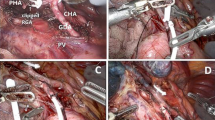Abstract
Background
Patients undergoing cytoreductive surgery (CRS) with hyperthermic intraperitoneal chemotherapy (HIPEC) are frequently admitted to the intensive care unit (ICU) for mitigation of potential complications, although ICU length of stay (LOS) is a significant driver of cost. This study asked whether a fiscal argument could be made for the selective avoidance of ICU admission after CRS/HIPEC.
Methods
Prospective data for select low-risk patients (e.g., lower peritoneal cancer index [PCI]) admitted to the intermediate care unit (IMC) instead of the ICU after CRS/HIPEC were matched with a historic cohort routinely admitted to the ICU. Cohort comparisons and the impact of the intervention on cost were assessed.
Results
The study matched 81 CRS/HIPEC procedures to form a cohort of 49 pre- and 15 post-intervention procedures for patients with similar disease burdens (mean PCI, 8 ± 6.7 vs. 7 ± 5.1). The pre-intervention patients stayed a median of 1 day longer in the ICU (1 day [IQR, 1–1 day] vs. 0 days [IQR, 0–0 days]) and had a longer LOS (8 days [IQR, 7–11 days] vs. 6 days [IQR, 5.5–9 days]). Complications and complication severity did not differ statistically. The median total hospital cost was lower after intervention ($30,845 [IQR, $30,181–$37,725] vs. $41,477 [IQR, $33,303–$51,838]), driven by decreased indirect fixed cost ($8984 [IQR, $8643–$11,286] vs. $14,314 [IQR, $12,206–$18,266]). In a weighted multiple variable linear regression analysis, the intervention was associated with a savings of $2208.68 per patient.
Conclusions
Selective admission to the IMC after CRS/HIPEC was associated with $2208.68 in savings per patient without added risk. In this era of cost-conscious practice of medicine, these data highlight an opportunity to decrease cost by more than 5% for patients undergoing CRS/HIPEC.


Similar content being viewed by others
References
Beal EW, Ahmed A, Grotz T, et al. Trends in the indications for and short-term outcomes of cytoreductive surgery with hyperthermic intraperitoneal chemotherapy. Am J Surg. 2020. https://doi.org/10.1016/j.amjsurg.2019.09.017.
Schwartz PB, Stahl CC, Vande Walle KA, et al. What drives high costs of cytoreductive surgery and HIPEC: patient, provider, or tumor? Ann Surg Oncol. 2020. https://doi.org/10.1245/s10434-020-08583-7.
Taheri PA, Butz D, Griffes LC, Morlock DR, Greenfield LJ. Physician impact on the total cost of care. Ann Surg. 2000;231:432–5. https://doi.org/10.1097/00000658-200003000-00017.
Mogal HD, Levine EA, Fino NF, et al. Routine admission to intensive care unit after cytoreductive surgery and heated intraperitoneal chemotherapy: not always a requirement. Ann Surg Oncol. 2016;23:1486–95. https://doi.org/10.1245/s10434-015-4963-8.
White B, Dahdaleh F, Naffouje SA, et al. Impact of enhanced recovery after surgery on postoperative outcomes for patients undergoing cytoreductive surgery and hyperthermic intraperitoneal chemotherapy. Ann Surg Oncol. 2021;28:5265–72. https://doi.org/10.1245/s10434-020-09476-5.
Webb C, Day R, Velazco CS, et al. Implementation of an enhanced recovery after surgery (ERAS) program is associated with improved outcomes in patients undergoing cytoreductive surgery and hyperthermic intraperitoneal chemotherapy. Ann Surg Oncol. 2020;27:303–12. https://doi.org/10.1245/s10434-019-07900-z.
Roudsari B, McWilliams J, Bresnahan B, Padia SA. Introduction to cost analysis in IR: challenges and opportunities. J Vasc Interv Radiol JVIR. 2016;27:539-545.e1. https://doi.org/10.1016/j.jvir.2015.12.754.
Dunn A, Grosse SD, Zuvekas SH. Adjusting health expenditures for inflation: a review of measures for health services research in the United States. Health Serv Res. 2018;53:175–96. https://doi.org/10.1111/1475-6773.12612.
Dindo D, Demartines N, Clavien PA. Classification of surgical complications: a new proposal with evaluation in a cohort of 6336 patients and results of a survey. Ann Surg. 2004;240:205–13. https://doi.org/10.1097/01.sla.0000133083.54934.ae.
Iacus SM, King G, Porro G. Causal inference without balance checking: coarsened exact matching. Polit Anal. 2012;20:1–24. https://doi.org/10.1093/pan/mpr013.
Ho D, Imai K, King G, Stuart EA. MatchIt: nonparametric preprocessing for parametric causal inference. J Stat Softw. 2011;42:1–28. https://doi.org/10.18637/jss.v042.i08.
King G, Nielsen R. Why propensity scores should not be used for matching. Polit Anal. 2019;27:435–54. https://doi.org/10.1017/pan.2019.11.
Hair JF, Risher JJ, Sarstedt M, Ringle CM. When to use and how to report the results of PLS-SEM. Eur Bus Rev. 2019;31:2–24. https://doi.org/10.1108/EBR-11-2018-0203.
Core Team. R: a language and environment for statistical computing. R Foundation for Statistical Computing. 2020. https://www.R-project.org/.
Squires MH, Staley CA, Knechtle W, et al. Association between hospital finances, payer mix, and complications after hyperthermic intraperitoneal chemotherapy: deficiencies in the current healthcare reimbursement system and future implications. Ann Surg Oncol. 2015;22:1739–45. https://doi.org/10.1245/s10434-014-4025-7.
Lu PW, Fields AC, Shabat G, et al. Cytoreductive surgery and HIPEC in an enhanced recovery after surgery program: a feasibility study. J Surg Res. 2020. https://doi.org/10.1016/j.jss.2019.10.042.
Siddharthan R, Dewey E, Billingsley K, Gilbert E, Tsikitis VL. Feasibility and benefits of an enhanced recovery after surgery protocol for patients undergoing cytoreductive surgery and heated intraperitoneal chemotharpy: a single-institution experience. Am J Surg. 2020. https://doi.org/10.1016/j.amjsurg.2019.06.019.
Acknowledgements
We thank Deborah Lemaster for her assistance in data abstraction. The research reported in this publication was supported by the National Institute of Environmental Health Sciences (NIEHS) (National Institutes of Health Award no. T32 ES007015). The content is solely the responsibility of the authors and does not necessarily represent the official views of the National Institutes of Health.
Author information
Authors and Affiliations
Corresponding author
Ethics declarations
Disclosure
There are no conflicts of interest.
Additional information
Publisher's Note
Springer Nature remains neutral with regard to jurisdictional claims in published maps and institutional affiliations.
Supplementary Information
Below is the link to the electronic supplementary material.
10434_2022_11967_MOESM1_ESM.docx
Supplemental Table 1: Secondary Analysis with the Addition of Operative Time to the Weighted Multiple Variable Linear Regression (DOCX 13 kb)
Rights and permissions
About this article
Cite this article
Schwartz, P.B., Stahl, C.C., Vidri, R.J. et al. Rethinking Routine Intensive Care After Cytoreductive Surgery With Heated Intraperitoneal Chemotherapy: The Fiscal Argument. Ann Surg Oncol 29, 6606–6614 (2022). https://doi.org/10.1245/s10434-022-11967-6
Received:
Accepted:
Published:
Issue Date:
DOI: https://doi.org/10.1245/s10434-022-11967-6




